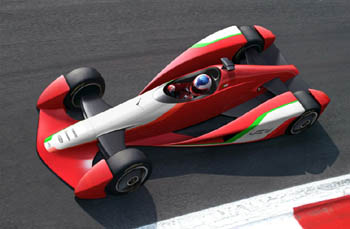 |
|
The LF1 features a central structure that
houses the cockpit and engines in the true
style of a racing car, along with a large
from wing and side pods that wrap round the
rear wheels. Integrating the styling and
aerodynamics has been a key aim of this
project. |
|
 |
|
|
|
 |
|
Tris is a 3-door hatchback that showcases
new methods of lowering vehicle development
and manufacturing. The three doors on Tris
are identical, as are the bumpers and the
lights/indicator units. |
|
 |
|
|
|
Italian design house Fioravanti will present two very
different concept cars at the Geneva Motor Show next
week, a sports car that aims to bridge the gap to racing
cars, as well digging out its Tris urban car from 2000.
With its brand
new LF1 concept Fioravanti, which celebrated its 20th
anniversary last year, is aiming to bring technology from
Formula 1 to high performance road cars. It represents a
change in direction for Fioravanti from its recent concepts
including Hidra (2008) and Thalia (2007) and the company has a
tradition of presenting forward looking concept cars at the
Geneva Motor Show. The LF1 features a central structure that
houses the cockpit and engines in the true style of a racing
car, along with a large from wing and side pods that wrap
round the rear wheels. Carefully integrating the styling and
aerodynamics has been a key aim of this project.
The second
concept that Fioravanti will present at the Swiss show is
its Tris urban hatchback car from 2000. Tris is a 3-door
hatchback that showcases new methods of lowering vehicle
development and manufacturing. The three doors on Tris are
identical, as are the bumpers and the lights/indicator
units. By reusing parts, the costs of the project are
reduced. Regarded as being ahead of its time in 2000 when it
was first shown, Fioravanti has brought out the Tris for
this year's show as the project's fundamental principles are
more relevant today.
Fioravanti was
set up in 1987 as an architectural practice working on the
Japanese market, designing homes in Tokyo and several
clubhouses for golf courses in the Tokyo area. In 1991
Fioravanti diversified its activities into services to the
automotive industry, focusing in particular on transport and
industrial design. The company expresses its philosophy in
three concepts: to design is to engrave upon reality; style
is a means of perception; and to perceive innovative
concepts through awareness of the past.
The company headquarters are housed in Moncalieri, an
historic town lying in the Piedmont foothills outside the
city of Turin, Italy. By choosing to work out of a building
dating back to the 13th -16th centuries, the company is
underlining its corporate philosophy: innovative conceptual
design in all fields of transport, using leading-edge
technology (CAS, CAD, CAM, CFD) in an ambience permeated
with the creative beauty of old-world Italy. The same
corporate philosophy of sensitivity to environmental and
ecological demands underlies the company’s choice of site
for its show area for models and prototypes - a natural
setting, surrounded by wide open spaces.
C.E.O. Leonardo Fioravanti worked twenty-four years with
Pininfarina, where he personally designed some of the most
famous Ferrari road cars and became Managing Director and
General Manager of Pininfarina’s research arm. During the
years 1988-1991 he was with the Fiat Group, first as deputy
General Manager at Ferrari and then as head of Fiat’s design
centre.
In 1991 Leonardo
Fioravanti left Fiat to diversify the activities of his own
company, Fioravanti SRL, into services to the automotive
industry, focusing in particular on transport and industrial
design. The design process harnesses both traditional and
advanced methodologies. The most important element in the
Fioravanti business and design philosophy is the study of
and research into innovative concepts, which in turn
translate into the vehicle’s architectural layout and
culminate in formal styling. Feasibility studies,
engineering and computational aerodynamic research are
developed simultaneously. The final phase consists of the
building of models and prototypes which then undergo
aerodynamic testing in a wind-tunnel.
From 1991-1993 the company worked exclusively for the Fiat
Group’s automobile marques - Fiat, Lancia, Alfa Romeo -
developing several projects connected to production
programmes. In 1994 the company designed and built Sensiva,
a highly-innovative proposal for a hybrid sports car, and
presented it at the Turin Motor Show. The project, which
encompasses several ecological features, is based on a
unique sensitive tyre unit, patented by Fioravanti SRL in
Europe, the United States and Japan.
Fioravanti SRL was invited to join the Italian delegation to
the EVS 12 Show at Los Angeles and to enter the Compasso
d'Oro awards with Sensiva. In addition, some details of the
design, as well as some of its components, formed part of
the exhibits at the 1995 'Torino Desi exhibition. In 1996
Fioravanti SRL exhibited two economy vehicle design projects
at the Turin Motor Show: Flair', based on the Fiat Bravo
chassis, was a 2+2 coupe', aerodynamically designed (Cd =
0.18) to reduce fuel consumption and featuring air brakes. 'Nyce'
was an economy vehicle for the leisure market, whose basic
concept, a Fiat/Fioravanti patent, is a symmetrical door
which opens both ways, reducing the number of expensive body
parts to keep costs down.
In addition the company has recently produced several
projects in the field of marine and industrial design and is
currently working with several automotive manufacturers
outside Italy. Fioravanti SRL is a member of ANFIA, ADI and
ATA, all of which are Italian associations connected with
industrial and, more specifically, automotive engineering
and design.
|